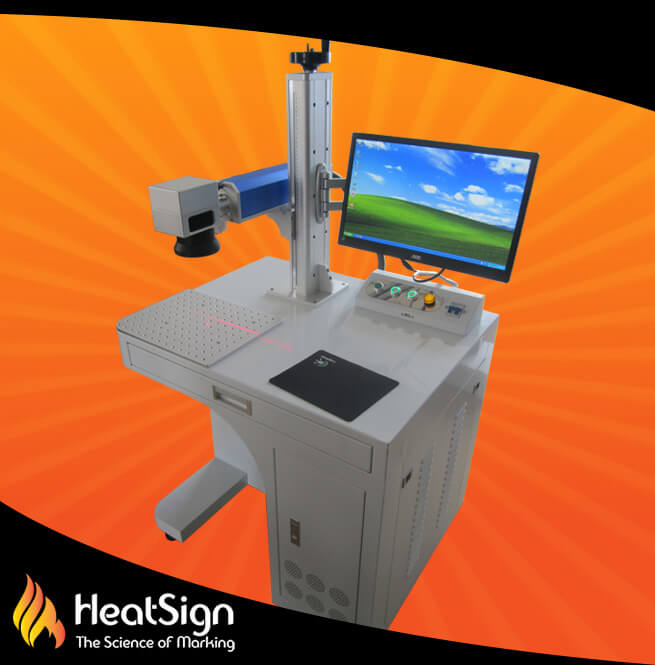The marking of metal depending on the technology of printing can be performed by mechanical or laser method.
Metal marking devices allow permanent marking and variable data can be used, applied at high speeds with flexibility in operation ensuring maximum product tracking reliability.
Metal marking can be used at:
– Bar code printing, 2D codes, variable content, graphics and logos
– Possibility to mark the hardest materials with durable codes which are not deleted
– Exceptional reliability and flexibility in operation with minimal maintenance required
– A complete solution for special purposes and the ability to integrate into existing manufacturing processes

Laser Marking
Laser technology provides permanent marking of metal by printing or engraving with high resolution and exceptional efficiency and cost-effectiveness.
The laser has served well for many years, especially when it comes to laser engraving and laser marking of metals.
Not only soft metals such as aluminum, but also steel or very hard alloys can also be accurately, legibly and quickly marked using a laser.
Annealing, with certain metals such as steel alloys, allows for corrosion-resistant marking.
Through this process, there is no damage done to the surface’s structure, and the mark is permanently applied.
In many industries, products made of metal are marked by laser: Application ranges from labeling industrially produced serial products for their traceability, right down to the personalization of promotional items with a logo or names.
If you are interested and need fiber laser marking machine, click here.
Materials suitable for laser marking and engraving are:
– Aluminum
– Stainless Steel
– Hardened metals
– Titanium, titanium alloys
– High-speed steels
– Copper
– Anodized aluminum
– Brass
– Precious metals (e.g. silver, gold)
– Coated metals
Laser Marking of Metals in the Industrial Sector
The use of lasers for marking metals is typically used for marking products with their characteristics and codes for traceability.
This kind of application is found in electronics and electrical industry, mechanical engineering and the tool manufacturing industry, in sheet metal processing, in medical technology, in promotional items, jewelry and in the automotive industry.

Application of lasers in the field of industry:
– Labeling the products as protection against plagiarism
– Production information e.g. date of production, batch or serial number
– Functional laser marking e.g. size, diameter, etc.
– Data matrix codes for quality assurance
– Permanent traceability codes
– Laser production of nameplates etc.
Color Marking on Stainless Steel
A special method of marking by annealing on metal involves color marking on stainless steel.
Starting with the technical capabilities of MOPA (Master Oscillator Power Amplifier) lasers used only by some of the best manufacturers of fiber laser marking machines there is possibility of marking stainless steel with a variety of reproducible colors, providing processors the ability to label their products with color designations.
This allows manufacturers of stainless steel products to create a special color labels, such as company logo or functional labels such as hot and cold tags on stainless steel accessories.

Industries That Use Color Marking
– Manufacturers of knives and cutlery wishing to decorate their stainless steel products with color logo
– Engravers and workshops looking to expand their product range through new opportunities
– Kitchen appliance manufacturers who want to decorate their stainless steel appliance front with their color logo
– Housing components: processors of stainless steel from other industries who want to stand out from the competition by using colored labels.
The Purpose of Buying an Industrial Metal Marking Laser
Labeling metal with the use of machines for laser engraving is very precise and clean way of processing metals.
Marking in the form of serial numbers, matrix codes and logos can be added to products and components at the highest resolution.
Marking or engraving is done by laser, contactless and without the need for preparatory or post-processing.
Annealing marking provides laser marking that is resistant to acids, chemicals and corrosion and does not damage the metal surface.
How Laser Technology Works and Benefits of Using it
– Cost-effective production
Direct labeling does not increase the cost of consumables such as toners, chemicals, pastes or sprays.
The need to handle and dispose of expensive materials has been eliminated.
There is no need for preparatory or follow-up procedures.
Tool wear has been eliminated.
– Labeling takes a few seconds and gives more effect
It is possible to quickly label a variety of data, e.g. serial numbers, codes.
Wide range of marking is possible without the need to replace or change tools
– Permanent engravings
Laser marking is, unlike other technologies, durable and resistant to abrasion, heat and chemicals.
This is extremely important for traceability and quality assurance purposes.
– Perfect markup results – fine tools
Precision and small shapes can be marked with extreme precision.
The marking process can be combined to clean up the material after processing, or to create greater contrast (e.g. with matrix codes).
– Incredible design opportunities
Virtually any design can be created with a laser.
It is even possible to create 1 point fonts and small shapes that are still clearly legible.
Full freedom when designing texts, logos, tags, barcodes or serial numbers.
Even photos can be produced in the shortest possible time.
– Contactless and reliable material processing capabilities
There is no need to tighten or fix the material.
Saves time and delivers consistently good results.
– Color marking on stainless steel
The laser can even produce color markings on stainless steel.
Exclusive color logo marking.
Functional color marking on stainless steel products.
